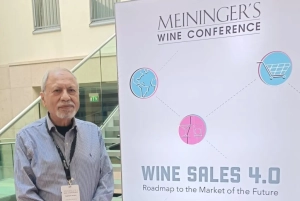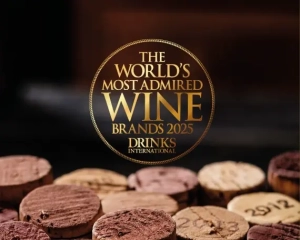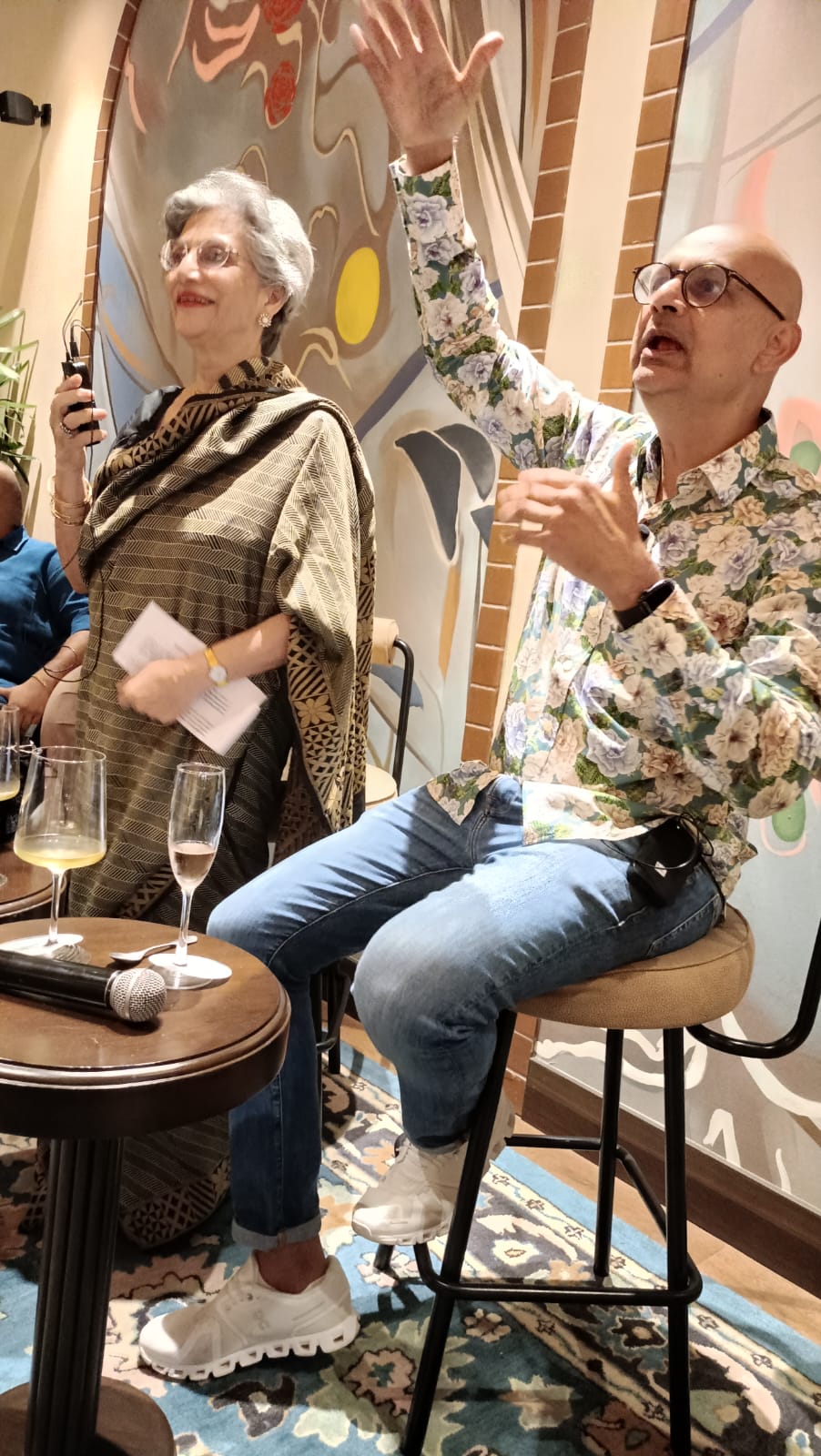
Let the Proceedings Begin
Posted: Tuesday, 03 Sep 2024 23:05
Sula’s exciting Wine Journey completes 25 years

It was perhaps the first time after Sula’s IPO came out in December 2022 that Rajeev Samant, Founder CEO of Sula Vineyards could find free time to visit Delhi and talk on a public platform of Sula’s journey since the first vintage of Sula was harvested.
The early Gaja connection
During an evening of fun, wine and Sula, organised by Sula in conjunction with Reva, the two chatted about the journey as the full house listened as the two shared the journey. Quickly glancing over the early journey, Rajeev admitted that they had felt that Nashik offered a better soil for white wines. What he did not tell was that he had also quietly flown to Tokyo 20 years ago with a couple of bottles of Sauvignon Blanc to visit Vinexpo Japan where he met Angelo Gaja who was exhibiting Gaja wines.
Also Read : SulaFest is out but Sula charges ahead with Wine Tourism
Angelo was really impressed with the wine. He later told me, ‘it was a very pleasant wine. More importantly, it was neither New Zealand nor Sancerre with its own identity. Gaja Distribution ordered a sample lot and even placed an order of a palate that was appreciated by all those who tasted and helped boost confidence in the wine.
Rajeev the Brand Ambassador
 Thus Rajeev had developed a great reputation of being his own Brand Ambassador without fuss. When I was able to contact him after locating his email address as President of Delhi Wine Club, he agreed instantly to host a wine tasting for the club members and flew down to present the wines himself at the Taj Palace Hotel even though his marketing head accompanied him. One would find him today in London and tomorrow in Canada presenting his wines personally!! Ever ready to promote his wines!!
Thus Rajeev had developed a great reputation of being his own Brand Ambassador without fuss. When I was able to contact him after locating his email address as President of Delhi Wine Club, he agreed instantly to host a wine tasting for the club members and flew down to present the wines himself at the Taj Palace Hotel even though his marketing head accompanied him. One would find him today in London and tomorrow in Canada presenting his wines personally!! Ever ready to promote his wines!!
Sula Champagne
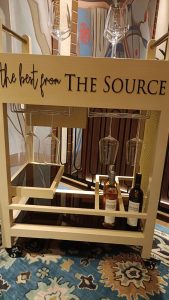
Rajeev has been extremely humble and flexible about the wines and his company, devoid of any arrogance at least in the formative years. He introduced Sula Brut Champagne as the sparkling wine to compete with Marquis de Pompadour from the king wine producer then known as Champagne Indage. When I pointed out to him that he could not call his bubbly as Champagne under the GI laws in India, he feigned ignorance but quietly removed ‘Champagne’ from the following vintage. It is a matter of record that Champagne Indage was obliged to even change the name of the company to Indage Vintners!
Introducing Screw Caps
Similarly, he had attended a conference in early 2000s on screw-caps in New Zealand when 100% of closures used by Sula and in fact all Indian wines, including Indage and Grover used cork closures. But following his example, today almost 100% wineries are using screw-caps (barring very high-ended wines) and general consensus is that this has helped wines to remain fresh and improved quality.
Also Read : Robert Joseph:India could produce Great Wines one Day-Part 1
Premiumisation of wines
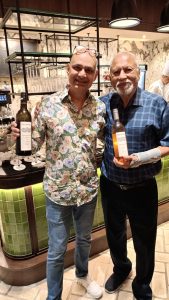
Rajeev emphasized that the company has been focusing on premiumisation of wines, especially after Covid. In fact all the wines presented this day for guided tasting by Rajeev, were premium wines. An astute business visionary that he is, Rajeev realized that the future of Indian wines can be sustainable only if high quality wines can be offered of consistent quality and at reasonable prices. He did not join the race for most expensive premium wines but kept high quality at affordable prices, keeping high volumes he had in mind. He never aspired to join Grover, Fratelli, KRSHMA and now Chandon (Aurya)and reach for the moon in terms of prices.
Earlier share of inexpensive wines
But this was not always like that. He has had his share of DIA, Samara, Satori, and Madera some of which were designed to compete with the comparable priced wines from Indage. Incidentally, never afraid of competition, he was the first one to introduce varietals (Grover had earlier started using wine grape blends, even as Indage was tinkering with the grape variety and quality, among other things) Sula also took pride in promoting Nashik Port (mercifully not copying Goan Port, in that no ethyl alcohol was added to make it a fortified wine and not violating the international norm of Port wines.
Also Read : Blog: My Journey with Sula and Samant
Pioneer if wine tourism
A pioneer of wine tourism in India, Rajeev did mention how they have been promoting wine tourism in India, with the number of people tasting for the first time at the winery being highest (though unverified claim) but one does not know of any another winery in the world hosting 400,000 guests in a year, now catering to wine tourists from India and even overseas.
Rise of Sula Fest
An important aspect of his journey he did not share with Reva was the hugely successful Sula Fest he had curated at the winery and made it a profit center besides being a great brand promoter. As it was creating new highs and making Sula Vineyards a big promoter of music, what with internationally acclaimed bands from Europe and the US and the top names like Kailash Kher and Shankar Mahadevan etching a mark in the mind of wine and music lovers, just before Covid, decided to postpone the fest and finally bring the curtains down because of risk/reward and headache quotient.
Also Read : Ten Years of delWine and Sula Vineyards
Thirteen proved an unlucky number for SulaFest. After 13 annual events (2008-2020), it fell prey to Covid-19. No events could be organised for 2 years and even the Wine Tourism took a nosedive. While the hard core loyalists kept on hoping it would be revived soon, Sula showed the red flag after the 2020 event and this became a closed chapter.
Four Brands within Sula
During a Conversation with Reva, Rajeev emphasized that the company’s objective was to focus on quality wines at various price points and so had gradually introduced 4 labels in the market- Sula. The Source, Dindori and RASA- 8 variants of which were tasted by Rajeev this evening.
Also Read : Sula Celebrates 15 years in Tropicale Style
The Fall of Indage and Meteoric Rise of Sula
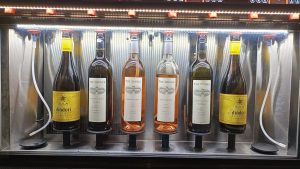
The most important aspect Reva and Rajeev missed about the journey was the 2008-2009 period when Chateau Indage, the ruling producer crashed like a pack of cards. Grover Vineyards was not pro-active to fill the vacuum created when Indage failed to supply wines demanded by the market even though it had been supposedly controlling 70% of the market. Sula walked right in and one by one started conquering all the bastions left uncovered until it became the leader, a position it maintains even today with a wide margin.
Killing two birds with one stone
During the heyday, came Sula’s 15th Anniversary in 2015. Just prior a couple years earlier, the Champagne behemoth Moet et Chandon (LVMH) had introduced 2 Nashik-born versions of Chandon sparkling- at slightly higher prices than the market of only Rs. 200-300 in 2013. Sula launched Brut Tropicale in 2015, its pink version using a small portion of red grapes like Shiraz and Pinot Noir giving a nice pink colour, with great aplomb at St. Regis Mumbai.
Sula was the first one to offer an attractive packaging with colorful Indian motifs, emulated by others including Chandon and Grover. Knowing the wine drinkers’ increasing penchant for Prosecco in India Sula quietly switched to the cheaper Charmat method, saving a lot of money in costs. Today 9 years after the launch, Tropicale is still leading the pack in volume sales of premier bubblies and surely contributing even more to the bottom line, making Sula from Hero to a SuperHero.
Also Read : Sula: From Zero to Hero in Ten Years
Tasting of 8 wines at Captain’s Cellar
During Covid, Rajeev spent the maximum time in Nashik looking personally at various angles of winemaking. This is when Sula decided to go premium-class only with the 4 premium Brands in place- Sula, Dindori, Source and RASA.
The evening at Captain’s Cellar was spun around 8 of these wines- Sula Brut Tropicale (Rs. 1340), my personal favourite Source Grenache Rose (Rs. 1200), Sula Dindori Chardonnay (Rs. 1350), Source Sauvignon Blanc (Rs.1440),and all 3 variants of Rasa –Zinfandel (Rs.1510), Cabernet Sauvignon (Rs.2400), Syrah (Rs.1600) and finally Sula LH Chenin Blanc Rs.(1080)-all premium wines but costing Rs.1200-1600, except The Cabernet Sauvignon which matures well for up to 10 years. What a fine example of affordable Indian Premium wines.
Also Read : Sula Nashik
It was not surprising to have almost 100 % hands going up when asked if the audience liked the wines, but it was surprising when the show of hands indicated that 90% had never heard of or tasted Sula wines. It just shows how big the Indian wine market is and how much more education is required. Events like this, though expensive to organize, would achieve a lot in terms of improving the wine culture in India.
Subhash Arora



